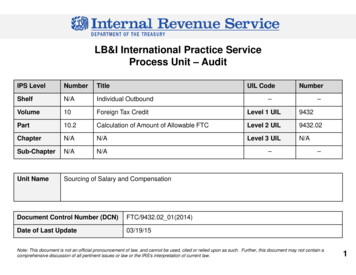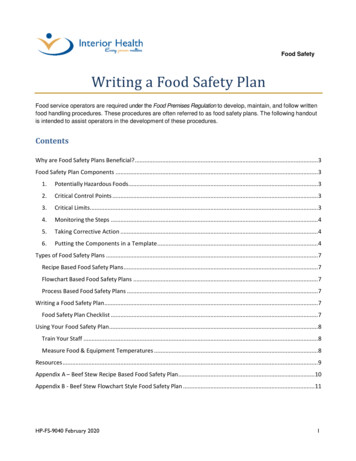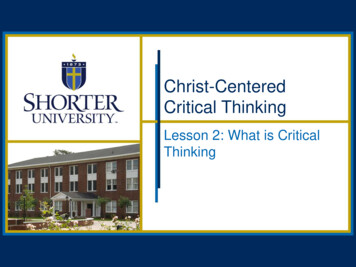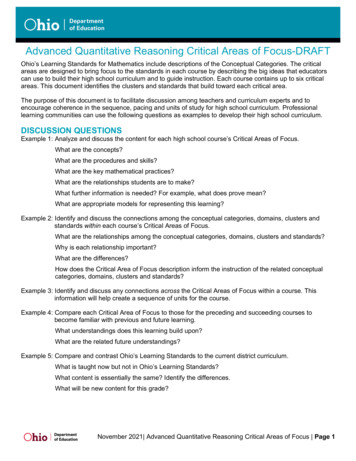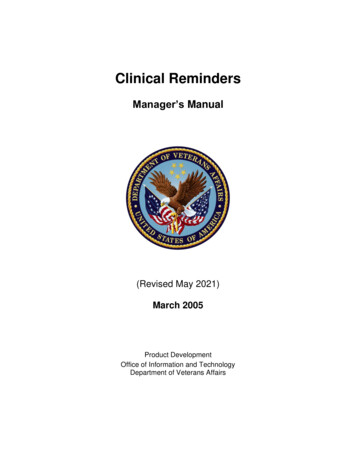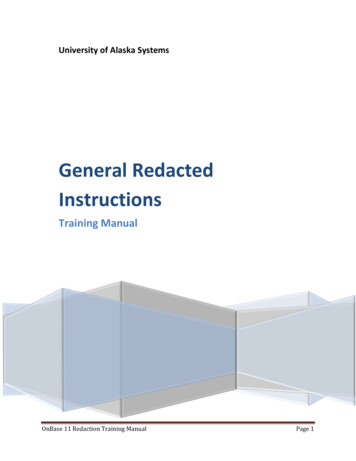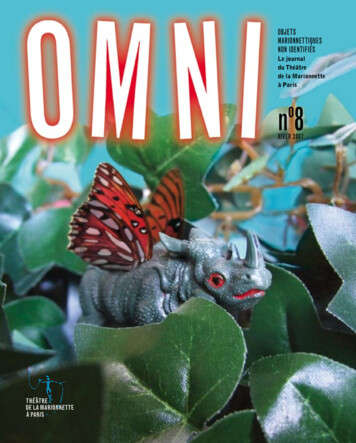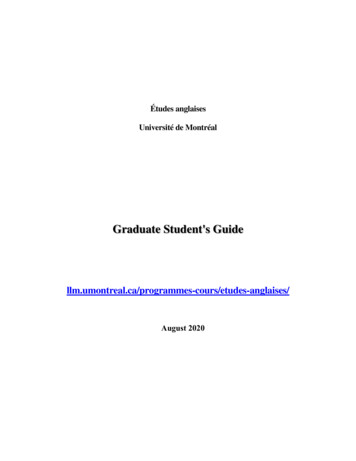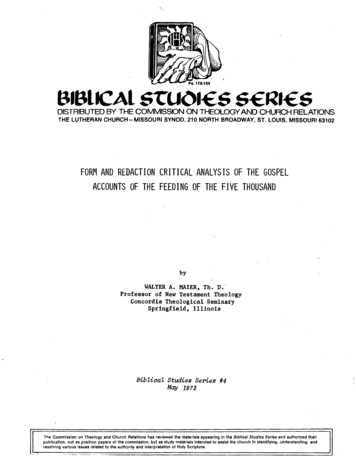
Transcription
a1aLJCAl srUOI S S RI SDISTRIBUTED BY THE COMMISSION ON THEOLOGY AND CHURCH RELATIONSTHE LUTHERAN CHURCH-MISSOURI SYNOD, 210 NORTH BROADWAY, ST. LOUIS, MISSOURI63102FORM AND REDACTION CRITICAL ANALYSIS OF THE GOSPELACCOUNTS OF THE FEEDING OF THE FIVE THOUSANDbyWALTER A. MAIER, Th. D.'Professor of New Testament TheologyConcordia Theological SeminarySpringfield, IllinoisBibZiaaZ Studies Series #4May 19?3T e Commission on Theology and Church Relations has reviewed the ri1111erlals appearing In tho Biblical Studies Series and authorized theirpubllcaUon. not as posl!lon papers of the commission, but as study materials Intended to assist the church In Identifying. understanding, andresolving various issues related to the authorily and Interpretation of Holy Scripture.
TABLE OF CONTENTSThe "Criticisms" Comprising the Historical Critical Method, . 3Textual - Literary - Historical - Form - Redaction - ContentForm Criticism and the Gospels. , ,Three Laws - Four Procedurea - Four Literary TypeaForm Critical Analysis of the Four Feeding Narrativea . .6Place and Time - Miracle Story - Tradition Development - Variationa Primitive TraditionA Criticism of the Form Critical Procedure, . . .8Editorial Fabrications - Miracle Storm Form - Laws Governing the Formulationof Tradition - Textual Integrity10Redaction Criticism . .Bornkamm - Conzelmann - MarxsenRedaction Critical Analysis of the Four Feeding Narrativea.12Hark - Matthew - Luke - John - MessiahshipCriticism of Redaction Critical Procedure15A Concluding Word16FOOTNOTES .17BIBLIOGRAPHY.22APPENDIX:23Texts of the Four Gospel Accounts.
FORM AND REDACTION CRITICAL ANALYSIS OF THE GOSPELACCOUNTS OF THE FEEDING OF THE FIVE THOUSANDAn account of the miracle of Christ's feeding the five thousand appears in each of the four NewTestament Gospels, Mark 6:32-44, Matt. 14:13-21, Luke 9:10b-17, and John 6:1-15. As is the case withthe re.st of the evangelic material, the narratives of this miracle have been subjected to the carefulscrutiny of Bible students. In their study of these pericopes many scholars have employed what is technically referred to in the field of contemporary New Testament scholarship and modern theological literatureas the "bistorical critical method. 11It ill be the purpose of this paper to offer a short overview of modern form and redaction analysisof the narratives of the feeding of the five thousand as to assess critically the validity of variousscholarly positions and conclusions.The "Criticisms" Comprising the Historical Critical MethodBefore proceeding to the form and redaction critical analysis itself, it will be useful to offer afew words of explanation concerning each of the "criticisms" or investigative disciplines which comprisethe modern historical critical method of Bible study.As these are defined, we should note on the one hand 1 that every student of the Old and New Testamentis interested in many of the questions with which these "criticisms" concern themselves, Every conservative scholar of the Scriptures too engages in a kind of literary, form, and historical analysis of passagesand larger sections of the Bible, On the other hand, we ought to recognize that in most contemporarytheological literature these disciplines designate investigative procedures employed by scholars whooperate with presuppositions and assumptions in their study of the Biblical text which conservativescholars regard as arbitrary, not sanctioned by the ScriP,tures and therefore unwarranted. The formercritics practice what may from the conservative point of view be called "radical" historical criticalmethodology. Conservatives hold that such theologians as a result do violence to Biblical teaching intheir interpretation of the Scriptures.Textual Critic ismIt is taken for granted that all scholarly and critical investigation of the Scriptures begins witha mastery of the languages in which they were originally written: Hebrew, Aramaic, and Greek, Armed withthese linguistic skills, a Bible student proceeds to engage in textual criticism. Many manuscripts ofthe Old and New Testament Scriptures have come down to us from antiquity and contain a host of variantreadings. By following certain accepted rules the attempt is made to establish the text which conformsmost closely to the autographs, the original texts of the various Bible books.Literary CriticismLiterary criticism deals with such questions as the authorship, date, place and occasion of writing,recipients, style, purpose, unity of a given work. It seeks to determine also hether there are sourceswhich may lie behind a Bible book.Radical literary critics advance numerous extreme theories. Noting changes in vocabulary or style,different points of view, repetitions in the text and pointing to supposed logical gaps and logical digressions, they proceed to deny the authorship books which the Scriptures plainly assign to specific writers,e.g., the Pauline authorship of Ephesians and the Pastoral Epistles and the Petrine authorship of 2 Peter.HistQrical CriticismHistorical criticism investigates the historical data within a Bible book against the background ofsecular history; studies agreements and disagreements between a Scriptural document and the works ofsecular writers, where such are available; and ref era· to archeological findings and the pi:ac tices ofother ancient religions, when these are presumed to illuminate historical material in the Scriptural text.Radical historical criticism operates with a general assumption of modern scientific study of historythat nothing supernatural or miraculous ever did, does, or could happen. Those who hold to this view rejectas mythological all accounts of supernatural and miraculous events, all divine intervention in human affairs,such as reported in Scripture.
4Many practitioners of this discipline subscribe also to a basic postulate of the "Historygions School 11 1 namely the theory that the religions of the Old and of the New Testaments passedstages of evolution and growth like all ancient religions. In the course of their development,Biblical religions allegedly were strongly influenced by interaction with the religious beliefstices of peoples living around them,of Relithroughtheand prac-Form CriticismForm criticism is concerned with the various literary forma found in the Scriptures, It is truethat all students of the Bible seek to identify and classify the literary type of a given text (poetry,legal material', parable, apocalyptic, historical narrative) and to apply appropriate rules of il) . J:'pre tation to the kind of literature at hand. However, as the designation 11 form criticism" is generally employed in the field of Biblical studies, it signifies a radical, highly speculative investigative proce·dure.Radical form critics theorize that most of what is in the Bible represents a final written form ofmoral and religious stories and sayings which had circulated orally in Old Testament Israelite or NewTestament Christian communities, It is grantea tha some reports of historical occurrences and somesayings of religious leaders have been preserved in the oral and recorded tradition. But the Biblicalaccounts supposedly contain also much material which is purely the product of the pious, inventive imagination of the religious community.Form critics determine the literary forms of a text and by applying specific form critical Frinciples,strip away the additions or modifications which the community or the compilers.of the various Bibl bookspresum bly introduced into the tradition.After recovering what is deemed to be the original form ofea h tradition, the critics decide whether it in fact relates something that actually happened or wasreally said, thus passing judgment on its historicity. The determination of what. is historical in theevangelic tradition is one of the chief aims of form criticism.A subsidiary purpose of this critical analysis is to construct the "transmission history" of each ofthe many units of tradition which the Scriptures are presumed to contain. The attempt is made to tracethe way in which stories and sayings were supposedly changed from the time of their first telling untilthey were written down in the documents which constitute the Scriptures.Redaction CriticismRedaction criticism is closely related to form criticism, Presupposing and founded upon the resultsof the latter, this investigative technique focuses attention on the author of each book of the Biblein order to determine what part he played in its production, His contribution is seen as the collection,arrangement, and editing of units of tradition, as he incorporated them into a written record. It isconcluded that in the "redaction" of existing traditions he also fabricated and added material of his own.Redaction critics try to discover the theological motivation of an author, that is, the theologicalpoint of view which he seeks to express in and through his composition. This is presumed to be reflectedin the way in which he has augmented, modified, and connected the items from the tradition and featuredidentifiable theological emphases and motifs in his work.Content CriticismContent criticism is a wholly radical procedure, It allows the critic to sit in judgment on theScriptures and to reject these portions of Biblical teaching as unauthentic or non-normative which arenot regarded as reasonable or fitting to accept and inculcate in the present day and age.Form Criticism and the GospelsWe may now take a closer look at the basic concerns, assumptions, procedures and results of formcriticism, as employed in the examination of the New Testament Gospels, parficularly the'Synoptics. Ingeneral,modern form criticism accepts the main current theories of literary and historical criticisms.Building on their findings, moves on, as we have noted, to determine the oral tradition which circulatedin the church before the Gospels were written down and to discover the influences which moulded them.For details of the form critical procedure various works of Rudolf Bultmann,2 a prominent founding fatherof the form critical school of New Testament study·, may be consulted,Along with other scholars, Bultmann attributed considerable inventive editorial activity to the writersof the first three Gospels. It was his conjecture .that,. with the exception of the Passion Narrativ (which
5he supposed was a connected story already in the earliest tradition), the original tradition in its prelite ary, formative, oral period circulated chiefly in the form of short, detached, irreducible units,each complete in itself. When after some time the evangelists set about to write the Gospels, they werenot so much authors as collectors, editors, and compilers of narratives about Jesus and of sayings attributed to him.·These units of tradition, said Bultmann, are readily discernible in the Gospels and should be distinguished from the framework the evangelists supplied to connect them. All references to time and placein the Gospels, all transitional remarks, Bultmann held, ought be regarded as the evangelists' creation,and unauthentic,The next task was to concentrate attention on the traditional material in the Gospels itself, notall of which appeared to relate actual history. The challenge was to determine what was factual information regarding Jesus' life and teaching and what was fabrication. Bultmann stated that an approach toth solution of this difficulty could be made by way of acceptance of several assumptions,It ought tobe ,understood, he urged, that the units of the Gospel tradition were communicated by word of mouth andthen recorded in various fixed "styles," or identifiable "forms." Bultmann saw in the evangelic materialsuch forms as "I" sayings of Jesus, proverbs, parables, historical narratives, miracle stories, legends,and so on, (From these "forms," it may be noted, "form" criticism gets its name,)The different categories of form in which the Gospel tradition expressed itself, said Bultmann, wereoriginated by the church in accord with its developing needs in the areas of preaching, worship, instructiqn, and of controversy with those outside the congregational fellowships. He assumed that each formhad its own typical situation in the life of the Christian communities, its Sitz im Leben, out of whichit grew and which determined its continued usage in the circles of the faithful.Three LawsIt should also be supposed, Bultmann held, that the units of Gospel tradition underwent some alteration in the course of time and of their use in the church, Revisions of the material in the originaloral and literary forms took place, he theorized, according to certain laws by which development of anybody of tradition was shaped and controlled.·!: When units of tradition, whatever their form, are initially communicated, they are short, simpleportrayals of a scene in which normally only two speaking characters appear or the related event transpiresin a brief space of time. · The narrators do not provide long, unified accounts.2: In the process of their transmission-- whether orally or in writing -- the details of theseaccounts are subJect to fanciful elaboration and are frequently made more explicit and definite, As anexample of this Bultmann pointed to the difference between Mark 9:17 and Luke 9:38. The first reportsthat a father brought his demoniac son to Jesus; the second states in addition that he was an only son.In a similar way, he said, the palsied hand healed according to Mark 3:1 is designated as the right handin Luke 6:6; the severed ear of the high·priest's servant mentioned in Mark 14:47 is referred to asthe right ear in Luke 22:50; the two disciples sent to prepare for the passover celebration; unnamed inMark 14:13, are given the names Peter and John in Luke 22:8; and so on.Bultmann stated that a Gospel narrator frequently presented in direct discourse what his source gaveindirectly. In. this, he said, the tendency to specify more exactly could also be observed. Cited as anexample in Mark 8:32, containing a mere reference to the fact that Peter upbraided Christ, whereas in theexpanded account of Matthew 16:22, Peter is reported as saying, '"Be it far from Thee, Lord I"; also Mark14:1 and Matthew 26:1-2; Mark 14:23 and Matthew 26:27; Mark 15:37 and Luke 23:46; and other passages.3: Operative along with the tendency toward elaboration and greater explicitness was "the inclination,"as Bultmann saw it, "to impose a schematic idea of the course of Jesus' activity." He called attention tothe fact, for example, that Jesus' opponents were most frequently depicted as scribes and Pharisees, whosedisputes with Jesus were motivated by malicious intent. Bultmann wrote: "One may often observe or inferthat the earliest tradition had to do with unspecified questioners, whom the later narrators transformedinto ill-disposed scribes or Pharisees." An example supplied is this:It is quite characteristic that Mark has retained in its old form the story of the questionconcerning the greatest commendment, in accordance with which the inquirer is entirely honest,and in the end is praised by Jesus as not far from the Kingdom of God (xii. 28-34), In Matthewthis word of praise has fallen away, and the questioner appears from the outset as crafty andhypercritical (xxii. 34-40; cf, Luke x. 25),Bultmann added:Of course, many a polemical word of Jesus addressed to the scribes and Pharisees utay be entirelyhiStorical (Mark xii. 38-40; and most of Matt. xxiii. 1-31), but the schematic representation
6according to which the Pharisees and scribes are from the outset the sworn enemies of Jesusis certainly unhistorical.Four ProceduresOn the basis of the foregoing assumptions pertaining to the transmission of Gospel tradition in unitsof distinct form and their modification in the process of communication by word of mouth ·and from writtenrecord to written record, Bultmann was able to advance further procedures of his form critical methodology,If the first step was to distinguish the 'Gospel tradition from its editorial framework, the second wasto classify each unit of the traditional material according to form and endeavor to establish the life situation, the Sitz im Leben, which prompted the Christian community to make use of the given form in passingalong a particular unit of tradition.The third procedure, operating with any eye to the laws governing the formulation and development oftradition undertook to de.termine and strip away alterations and revisions of each form in order to recoverits early and pure expression. The history of each tradition's grqwth was revealed in this process.The fourth procedure, the ultimate goal of form critical study, was to pass judgment on the historicity of each "stripped" traditional unit,That meant to decide on the basis of modern, critical, historical canons whether the information such a unit presented regarding Jesus' teaching and life was factualor fabricated.Four Literary TypesBul.tmann discerned essentially four literary forms (genres, "Gattungen") i the evangelic material.These are: miracle stories, apothegms, 3 words of Jesus, and legends and myths.The characteristics ofthe first type are of particular interest for the present study, since it is this category into which theaccount of Jesus' feeding the five thousand falls,The Marburg scholar describes the pattern of the miracle account by using the record of a healing san illustration. Usually the narrative is given in three parts, In the first, the condition of thepatient is described, frequently with an emphasis upon the gravity of the illness or its long duration.In the second, the account of the healing itself is provided. The peculiar manipulations of the healerare often mentioned, as in Mark 7:33; 8:23. In the thi.rd part, unmistakable evidence of the healing isgiven: witnesses often exclaim in wonder and the person healed gives some clear demonstration of thefact that he has indeed been helped. Bultmann, a modern critical historian, feels that the miracles didnot actually occur, pointing out that the stories relating them bear a close resemblance to the Hellenisticmiracle-narratives after which they may have been patterned,Form Critical Analysis of the Four Feeding NarrativesThe cardinaJ:suffice to affordin the Gospels.other features inassumptions and procedures of Bultmannian form critical methodology provided above shouldan understanding of'the application of form criticism to the parallel feeding nerrativesThe analysis starts by noting the differences in the evangelists' accounts as well asthe texts which are likely to be the subject of particular form critical concern.5·When the basic study of the texts is completed, the analysis of the feeding narratives continues withthe application of the stegs of form critical investigation -- as enunciated, for example, by Bultmann -to the evangelic material.The goal is to determine the earliest and fundamental ecclesiastical traditioncontained in the feeding stories and in the process to be able to trace this tradition's growth in theChristian community.Place and TimeFirst, the references to place and time which serve to connect the feeding account with the largercontext of Each Gospel are singled out and rejected as unauthentic, editorial additions of the evangelists.Accordingly, Hark 6:32-33 are eliminated as editorial work, since these passages together with verses30 and 31 provide a link betw,en the sending out of the discip es reported in 6:7-13 and the story of thefeeding of the five thousand.Matt. 14:g3, Luke 9:10b, and John 6:1 are considered editorial insertionsfor similar reasons, as is also John 6:4.
7Miracle StoryAttention is next given to the form of the expurgated text of the parallel feeding narratives, Allfour are seen to have the marks of'a "miracle story." Each account is given in three parts: in the first,the seriousness of the people's situation is suggested; the impossibility of the disciples' satisfyingtheir need is made clear. In the secono, the account of the miraculous multiplication of the meager supplies and the distribution of food to the reclining assembly is provided.9 In the third, a corroborativeevidence is offered that a mighty (nature) miracle did indeed occur: the great multitude (5,000 men) issatisfied, and so much food was marvelously made available that twelve baskets of remaining fragmentscould be gathered. John 6:14-15 also reports the impression the miraculous feeding made on the crowd. 10Classed as a miracle story, the tradition of the feeding narratives is not regarded as the accountof an actual, historical happening in the life of Jesus, but as an invention of the church, produced tosatisfy its cultic needs, to exalt Jesus as Messiah and to edify the faithfu1. 11Tradition DevelopmentFinally, the evangelic material is examined to discover the earliest form of the tradition. For thispurpose differences in the tradition, as noted in the account of the four evangelists, are studied andthe development of the tradition is investigated.Various conclusions are drawn. The picture of thecrowds which stream out to Jesus and which are described as great (as in the first or izcond verse ofeach of the four parallel pericopes, and in other passages) is held to be schematized.The appearanceof the disciples, also referre to as the apostles and the twelve, who accompany Jesus is seen as simi·larly schematic and editorial, 3 although the feeding stories require the presence of some kind of gathering of people and some disciples. A semi-artificiality in the miracle's setting is found in the featurecalled '!ocenic duality", that s, the action is made to center principally about Jesus and his disciples,1considered as a single group.Var.iationsThe variations in the parallel miracle stories of the four evangelists are seen to be the result inlarge part of novelistic tendencies at work in the Christian community and influencing the Gospel writersthemselves,A desire to enhance the story is adjudged to account for the increase in'the miraculouselement. Evidence is found in Matt. 14:14 and Luke 9:11,15 which add healings to the text of Mark; inMatt, 14:21, where it is indi gted that the figure designating the number of diners is to be taken asexcluding women and children;in John 6:11, which states that the diners were given as much as theydesired; in John 6:14-15, whfch report the reaction of the people to the miracle, their identificationof Jesus with the predicted prophet and their intention to make Him king.It is held that a novelistic interest shows itself also in the individualization in the Johanninepericope . Here is singled out a lad from the multitude and two disciples are distinguished from thetwelve and identified· by name.l7 The same pious fancy is presumed to be responsible for the greaterexactness in specification found in the following passages: Luke 9:11, where not only the fact of ghrist's1teaching (reported in Mark) but also the content of his message (the Kingdom of God) is mentioned;atJohn 6:9, which designates the bread-cakes used in the miraculous feedings as made of barley; John 6:11,where the nature of the blessing Jesus spoke is explicitly stated to be a giving of thanks; John 6:12,where Jesus indicates that He wants no food wasted and directs the disciples to gather the left-over fragments of food; Mark 6:36 (and Luke l:l2), which refers to farms and hamlets roundabout whither the peoplemight go to buy food for themselves, 9.The fact that Matthew and Luke, more fre uently than Mark, join phrases and sentence.s of their narratives with conjunctions other than 11 and" (k,r.l ) and with conjunctive participles is. supposed to suggestthe passage of time and to indicate the desire to add explicitness of detail to th2 accounts -- probablyin the interest of providing a historically continuous and connected presentation. 0There are other features·of the feeding narratives which are considered the product of the devout.The use of direct speech (in the conversa21is held to be a mark of secondary formula ion.Attention is called to the tendency to produce new sayings of the speaker (Jesus), as in Joqn 6:5b and 12;Matt. 14:1BA Origination of action through the initiative of Jesus, is observed in the Johannine pericope,verses 5-6. 2 Reference to motive and feeling in Jesus which lead Him to act as He does are observed inMark 6:34 and Matt. 14:14, where Jesus is said to be filled with ·compas on for the people (in Luke 9:11He "welcomes" them) and then to proceed with teaching and healing them.iina J:I.t}at op of the Christian community and the evangelists.tiQn[s] etween Jesus and the disciples) in the four stories
8Primitive TraditionWhat is the substance of the primitive tradition found to be, after the parallel feeding narratives havebeen analyzed form critically and after editorial additions have been set aside? It is simply this, thatthe historical Jesus, at one time in the course of his ministry and probably when He was accompnied by afew of his disciples, met with a group of his countrymen and was Himself host to them·at an ordinary, butbountiful; meal . The origin of the later account of a miraculous provision of food might have been the fact that J susknew of a friend from whom He procured a sizable quantity of food and thus was able to serve it speedilyand so bountifully that there were many leftovers. Or perhaps the situation might have been this: Jesuskept the people with whom He was visiting interested for so long a time that they forgot about meals,delighted that they could eep conversing with .Him. Later others heard of this and circulated the storythat Jesus had fed the group in a miraculous manner.During the course of his remarks, Jesus probablyexpressed his concern about the Jewish people of his day, to the effect that they appeared to be as sheepnot having a shepherd.A Criticism of the Form Critical ProcedureA number of objections must be raised to th modern form critical analysis of the four New Testamentevangelists' stories of Christ's feeding the five thousand, as this analysis has now been briefly described,The same strictures apply to form critical procedure as employed in Gospel investigation generally today.They all center in the observation that the basic assumptions of form criticism are arbitrarily established and unwarranted.Editorial FabricationsBultmann asserts that all references in the Gospels to time and place which serve to connect up thesingle sections of narrative into a large context are the creative editorial work of the evangelists,and are therefore not authentic.This view may be challenged on the ground that, if an evangelist derived information on the life of Christ from oral tradition or a written source, it' is most likely thatthese sources already contained references to the temporal and local setting which were. taken over intothe Gospel narratives.Redlich's contention is entirely plausible, when he suggests that any tradition which influenced theevangelists would have containeda number of blocks of narratives connected together either by a common topical interest or by anorderly succession in time or in the form of an itinerary.Some of these incidents may havepreviously existed separately but that does not disprove our contention that the early Churchwas interested in matters' of time and place and was not devoid of the desire to know somethingof what Jesu did, where He happened to be, and when He performed certain miracles or utteredHis sayings."L 4Furthermore, if the authors of Matthew and John were the apostles by these names, then these men wereeyewitnesses of the events they describe and were not dependent on community tradition for their information on Christ'.s ·activities. At any rate, it does not follow that the details of time and place given inthe Gospels are of no historical or biographical value or that they do not convey accurate information concerning the chronology and setting of events as they actually transpired.There is therefore no good reason to reject as editorial inventions the connecting and orientingstatements at the beginning of the four feeding narratives which (taken in conjunction) report that forseveral reasons Christ and his disciples withdrew from the Galilean public after the twelve had returnedfrom their preaching tour; that they crossed the Sea of Galilee, the Tiberian, (probably leaving fromCapernaum and) landing at an unpopulated (but verdant) area in the vicinity of Bethsaida; that they·wereable to spend a short time together alone in a nearby mountain, before crowds, who had been impressed byJesus' miracles and followed Him and the apostles by land, found out where He was; that Jesus saw thepeople approaching Him. These features set the stage for the activity which followed as described by theevangelists.There is also no cause to doubt that it was, indeed, near the time of the Passover, whenthese events took place.Miracle Story FormBultmann and the form critics conclude that the form of the feeding narratives is that of the miraclestory, and this is correct.But the assumption that Jesus' miraculous deeds, reported by the evangelists,never did or could actually occur is founded on an anti-supernaturalistic bias, which relegates any evidence
9for the deity of Jesus Christ to the realm of the mythological and out-of-hand rejects all divine intervention and operation in human affairs. This anti-supernaturalism, as Robert Gundry says, "prejudiceshistorical enquiry and is theologically and scientifically out-of-2 te, for it rests on the rationalisticconcept of a closed universe and a rigid concept of natural law."Form criticism arbitrarily and unreasonably presupposes the unreliability of the New Testamentmiracle-records; its approach to them is marked by an extreme subjectivism in the establishment ofstandards for the recognition of what is supposedly unauthentic
FORM AND REDACTION CRITICAL ANALYSIS OF THE GOSPEL ACCOUNTS OF THE FEEDING OF THE FIVE THOUSAND An account of the miracle of Christ's feeding the five thousand appears in each of the four New Testament Gospels, Mark 6:32-44, Matt. 14:13-21, Luke 9:10b-

